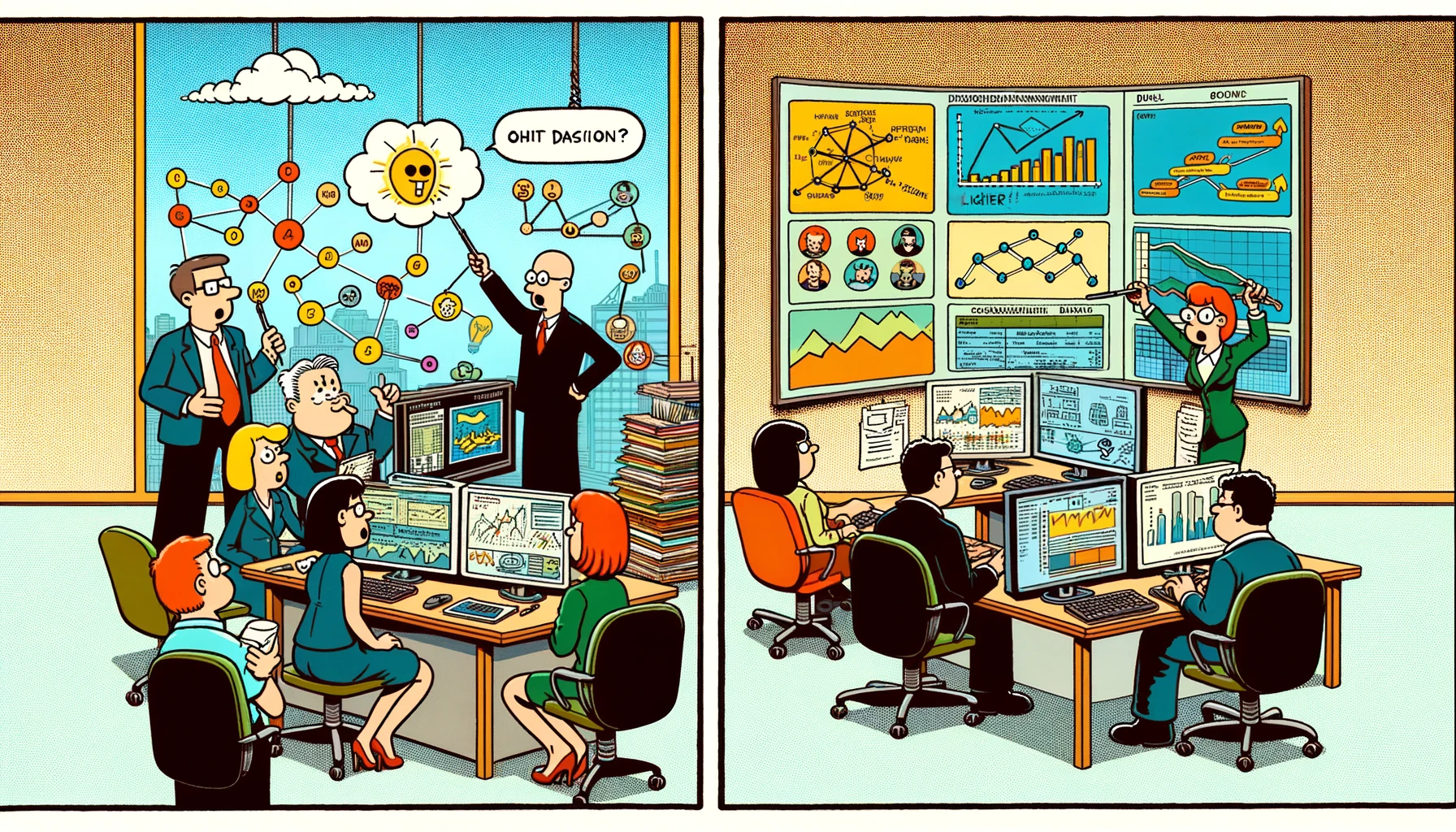
Blog post
Feedback Examples: How To Give Great Performance Feedback
best feedback strategies to motivate your team’s growth

We know that providing feedback to employees is crucial to their morale and growth. Moreover, how feedback is delivered can impact an employee’s decision to stay.
So, how can you ensure your performance feedback makes a positive impact?
Read on to learn the best feedback strategies to motivate your team’s growth.
Understanding Performance Reviews
Before we discuss how you can give great performance feedback, let’s define what makes a performance review effective.
A well-structured performance review compares an employee’s progress against the expectations of their role. However, this should be more than a bureaucratic checkbox.
Here’s how to make performance reviews actionable instead of arbitrary.
What should you include in performance feedback?
First, each performance review should include clear feedback from management. To best empower your employees, include the following in feedback conversations:
- Affirmation of the employee’s goals and their progress toward them. Even if they did not achieve a goal, acknowledge their efforts and provide guidance as needed.
- Context around their performance. Saying that someone scored 3 out of 5 on “collaboration” doesn’t help much. Sharing relevant feedback from their coworkers does. Focus on observed behaviors over personality traits. You can pull organic insights from a performance management solution such as Confirm.
- Detailed remarks about their strengths and weaknesses. Vagueness is the enemy of progress. Especially for women and underrepresented groups, it’s critical to share verifiable, actionable feedback.
What should you not include in performance feedback?
Performance reviews require tactful, constructive feedback. The goal is to empower the employee to improve within your company. Therefore, your reviews should avoid:
- Criticism without an illustration of the issue. Not only may your employee feel personally attacked, but they also won’t see how to correct the issue.
- Comparisons to other employees. This can cause workplace conflict that disrupts the employee’s potential for growth.
- Speculations about the employee’s work ethic or skillset. Always stick to the facts and investigate any misunderstandings.
- False praise. While this might seem encouraging, it won’t help your employees improve. It’s better to be honest yet constructive.
- Repetitive, vague commentary. You won’t see much improvement if you keep giving the same feedback again and again.
- Other employees’ remarks. Never refer to other employees’ statements or opinions about the person you’re reviewing. By the same token, don’t share details from your feedback session with others.
Key Guidelines for Employee Evaluation
It’s important to make your employee evaluations as fair and equitable as possible. We all have implicit bias that can sway our judgment. To resolve this issue and provide meaningful feedback, follow these steps.
Assess Individual Metrics
Before assigning ratings, get a full picture of an employee’s performance and collaborations from the perspective of those that work with them:
- For whom are they a source of help, advice, or energy?
- Where are they doing outstanding work?
- Where might they be falling short or need additional support?
You can gain these insights from a performance management solution such as Confirm.
Tip: watch out for bias in language. Consider whether your language or tone changes depending on to whom you’re giving feedback.
Connect Ratings to Measurable Data
Provide a rationale for any rating. Employees who see a low performance metric with no justification will feel demoralized, not motivated.
Link Feedback to Goals
Ask yourself the following questions before you begin the review:
- Why am I providing this feedback?
- For what purpose?
- How will I be giving this feedback?
- How does this feedback align with the company’s or employee’s goals?
Keeping these questions in mind can help you provide more actionable, unbiased criticism.
Measure Against Expectations
Evaluate the employee against your expectations for their role and level. If your feedback falls outside of that scope, they may feel they’re being treated unfairly. You can encourage them to go above and beyond if you’re willing to compensate them appropriately.
Consistency is Key
No matter how you provide employees feedback, ensure you’re using consistent criteria. Various managers may value different characteristics or metrics. To keep your ratings fair, standardize performance evaluations across your organization.
By incorporating Confirm, your evaluation of each employee can be more equitable. You can get actual data on influence, impact, and satisfaction.
You’ll also have access to information regarding specific things they’ve accomplished, as well as feedback from those who’ve worked alongside them in the workplace.
How to Give Good Feedback
Performance reviews should be equitable and actionable rather than arbitrary or unsubstantiated. Follow this process to ensure your employees get feedback that supports their growth.
Introduce the feedback as a constructive conversation rather than a trial.
NO: “Your performance has not been satisfactory. We need to discuss your future here.”
YES: “I’d like to share some observations that may help you grow within our company.”
Tip: Let your employee know they can ask any questions about your feedback.
Make sure that your employee understands you. Give clear details and examples for each criterion you give in your feedback.
NO: “You haven’t been a good team player.”
YES: “On the last project, you declined to join team meetings because you said you were too busy, but I noticed that you didn’t respond to the project manager’s requests, no matter how heavy or light your workload was.”
Make your feedback purposeful, so that it can help them align with the company’s values and improve their performance.
NO: “You’re a good worker and I hope you’ll keep it up.”
YES: “I’m impressed by your work ethic and I see you ‘acting as an owner.’ It’s crucial for our growth as we strive toward our goals.”
Lead with empathy rather than judgment.
NO: “Your performance has really declined from previous years. I don’t know what’s up with you.”
YES: “I’ve noticed a significant change in your performance from previous years. I’m not sure why, but I’d love to help you if I can.”
Sample Feedback Scenarios
Need more inspiration? Here are some examples of how to give your employees actionable feedback.
Scenario 1: Your Employee Has Exceeded Your Expectations
In her role as a web content leader, Maria goes above and beyond. She’s a skilled manager, able to delegate tasks to the right people while facilitating their growth.
Under Maria’s leadership, your company has increased web traffic by 30% over the past year.
In addition to being a fantastic leader, Maria is also a reliable troubleshooter. The other employees frequently ask her for help, and Maria always does so, no matter how busy she is.
However, you’ve noticed that Maria seems a bit disengaged recently. She’s showing warning signs of burnout, and you’re concerned that she may resign.
Sample Feedback 1:
“Maria, we deeply appreciate your work ethic and dedication to your team. You’ve achieved incredible results for our company. However, we’ve noticed that you seem a bit overworked. You’ve been logging longer hours and your coworkers have noticed a dip in your energy. Does that sound accurate? If so, is there something we can do to help you out?”
Scenario 2: Your Employee Has Met Expectations
In her position on the product development team, Gabriel fulfills all requirements and does his job well. He always arrives at the office on time and adheres closely to company standards.
However, his teammates report that he frequently requests their guidance on tasks he should already know. It’s distracting them from their work. Some also report that he only does the bare minimum, occasionally cutting corners.
So while Gabriel has technically met expectations, he creates a burden for others. You believe that he should take more initiative to solve his own problems.
Sample Feedback 2:
“Gabriel, you’ve done a good job on your tasks. However, we’ve noticed that you request extra help on certain tasks. As we thought you felt confident about those responsibilities, we want to ensure you have the resources you need to succeed. What can we do to help you take more autonomous ownership of your tasks?”
Example 3: When Your Employee Has Failed to Meet Expectations
Jordan has an issue with attendance. They sometimes skip work entirely, and when they do come into the office, they usually arrive late. Also, they often leave before the workday is over. As a result, there’s more pressure on their team, who has to pick up the slack.
Resentment is growing among Jordan’s coworkers, who have had to come in early and leave late to finish tasks that Jordan should have completed during their work hours.
When Jordan does come in, though, they produce exceptional work. However, the company’s attendance policy requires that chronically tardy or absent employees be fired.
Sample Feedback 3:
“Jordan, you do a fantastic job when you’re here. However, we do notice when you’re gone, and it puts a burden on the rest of the team no matter how much you do while you’re here. What would help you show up to work more consistently? Per our policy, you are at risk for termination, but we want to keep you and your talents on board.”
Understanding Confirm’s Role in Performance Feedback
Now that you’ve learned more about giving good feedback, use a performance management tool to house that feedback. These solutions yield valuable data that can help you track, analyze, and capture employees’ performance for effective feedback delivery.
For data-backed, actionable guidance, try Confirm. It provides quantitative insights, attrition risk assessments, and functional benchmarks you need to make your performance feedback as effective as possible.
You’ll also discover breakout performers, evaluate employees equitably, ace workforce planning, and more.
To find out if it’s right for you, request a demo now.
Latest posts

Ready to see Confirm in Action?
See why forward-thinking enterprises use Confirm to make fairer, faster talent decisions and build high-performing teams.









